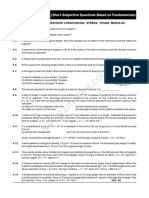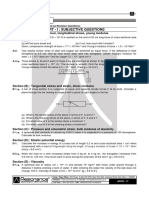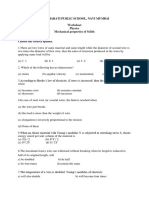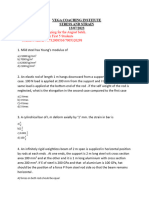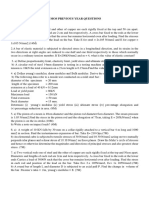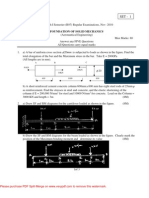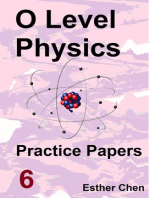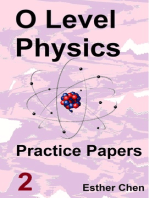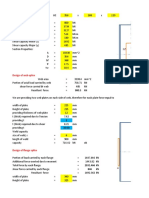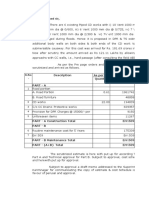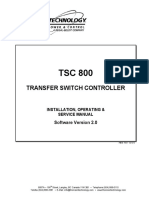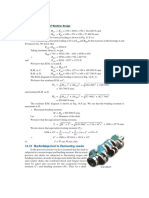Mechanical Properties of Solids: © Ncert Not To Be Republished
Mechanical Properties of Solids: © Ncert Not To Be Republished
Uploaded by
Veenus GirdharCopyright:
Available Formats
Mechanical Properties of Solids: © Ncert Not To Be Republished
Mechanical Properties of Solids: © Ncert Not To Be Republished
Uploaded by
Veenus GirdharOriginal Title
Copyright
Available Formats
Share this document
Did you find this document useful?
Is this content inappropriate?
Copyright:
Available Formats
Mechanical Properties of Solids: © Ncert Not To Be Republished
Mechanical Properties of Solids: © Ncert Not To Be Republished
Uploaded by
Veenus GirdharCopyright:
Available Formats
Chapter Nine
MCQ I
9.1 (a) (b) (c) (d) 9.2
Modulus of rigidity of ideal liquids is
infinity. zero. unity. some finite small non-zero constant value.
The maximum load a wire can withstand without breaking, when its length is reduced to half of its original length, will (a) (b) (c) (d) be double. be half. be four times. remain same.
9.3
no
The temperature of a wire is doubled. The Youngs modulus of elasticity (a) will also double. (b) will become four times.
tt o N be C re ER pu T bl is he d
MECHANICAL PROPERTIES OF SOLIDS
Exemplar ProblemsPhysics ( c ) will remain same. (d) will decrease. 9.4 A spring is stretched by applying a load to its free end. The strain produced in the spring is (a) (b) (c) (d) volumetric. shear. longitudinal and shear. longitudinal.
no
66
tt o N be C re ER pu T bl is he d
9.5 (a) Ycopper/Yiron Yiron Ycopper (b) (c)
2 Y iro n 2 Y co ppe r
A rigid bar of mass M is supported symmetrically by three wires each of length l . Those at each end are of copper and the middle one is of iron. The ratio of their diameters, if each is to have the same tension, is equal to
(d)
Yiron . Ycopper
9.6
A mild steel wire of length 2L and cross-sectional area A is stretched, well within elastic limit, horizontally between two pillars (Fig. 9.1). A mass m is suspended from the mid point of the wire. Strain in the wire is
2L
Fig. 9.1
(a) (b)
x2 2 L2 x L
Mechanical Properties of Solids
(c) (d) 9.7
x2 L x2 . 2L
The tension in the strings will be (a) the same in all cases. (b) least in (a). (c) least in (b). (d) least in (c). 9.8
Consider two cylindrical rods of identical dimensions, one of rubber and the other of steel. Both the rods are fixed rigidly at one end to the roof. A mass M is attached to each of the free ends at the centre of the rods. (a) Both the rods will elongate but there shall be no perceptible change in shape. (b) The steel rod will elongate and change shape but the rubber rod will only elongate.
no
(c) The steel rod will elongate without any perceptible change in shape, but the rubber rod will elongate and the shape of the bottom edge will change to an ellipse. (d) The steel rod will elongate, without any perceptible change in shape, but the rubber rod will elongate with the shape of the bottom edge tapered to a tip at the centre.
tt o N be C re ER pu T bl is he d
(a) (b) (c) Fig. 9.2
A rectangular frame is to be suspended symmetrically by two strings of equal length on two supports (Fig. 9.2). It can be done in one of the following three ways;
67
Exemplar ProblemsPhysics
MCQ II
9.9 The stress-strain graphs for two materials are shown in Fig.9.3 (assume same scale).
no
68
tt o N be C re ER pu T bl is he d
Fig. 9.3
(a) Material (ii) is more elastic than material (i) and hence material (ii) is more brittle. (b) Material (i) and (ii) have the same elasticity and the same brittleness. (c) Material (ii) is elastic over a larger region of strain as compared to (i). (d) Material (ii) is more brittle than material (i). A wire is suspended from the ceiling and stretched under the action of a weight F suspended from its other end. The force exerted by the ceiling on it is equal and opposite to the weight. (a) Tensile stress at any cross section A of the wire is F/A.
9.10
(b) Tensile stress at any cross section is zero. (c) Tensile stress at any cross section A of the wire is 2F/A. (d) Tension at any cross section A of the wire is F.
9.11
A rod of length l and negligible mass is suspended at its two ends by two wires of steel (wire A) and aluminium (wire B) of equal lengths (Fig. 9.4). The cross-sectional areas of wires A and B are 1.0 mm2 and 2.0 mm 2, respectively.
(Y Al
= 70 109 Nm 2 and Ysteel = 200 10 9 Nm 2 )
A steel
B Al
Fig. 9.4
Mechanical Properties of Solids
(a) Mass m should be suspended close to wire A to have equal stresses in both the wires. (b) Mass m should be suspended close to B to have equal stresses in both the wires. (c) Mass m should be suspended at the middle of the wires to have equal stresses in both the wires. (d) Mass m should be suspended close to wire A to have equal strain in both wires.
(a) (b) (c) (d) 9.13
the bulk modulus is infinite. the bulk modulus is zero. the shear modulus is infinite. the shear modulus is zero.
A copper and a steel wire of the same diameter are connected end to end. A deforming force F is applied to this composite wire which causes a total elongation of 1cm. The two wires will have (a) (b) (c) (d) the same stress. different stress. the same strain. different strain.
VSA
9.14
The Youngs modulus for steel is much more than that for rubber. For the same longitudinal strain, which one will have greater tensile stress? Is stress a vector quantity ?
9.15 9.16
Identical springs of steel and copper are equally stretched. On which, more work will have to be done? What is the Youngs modulus for a perfect rigid body ? What is the Bulk modulus for a perfect rigid body ?
9.17 9.18
SA
9.19
no
A wire of length L and radius r is clamped rigidly at one end. When the other end of the wire is pulled by a force f, its length increases by l. Another wire of the same material of length 2L and radius 2r, is pulled by a force 2f. Find the increase in length of this wire.
tt o N be C re ER pu T bl is he d
69
9.12
For an ideal liquid
Exemplar ProblemsPhysics 9.20 A steel rod (Y = 2.0 1011 Nm2; and = 1050 C1) of length 1 m and area of cross-section 1 cm2 is heated from 0 C to 200C, without being allowed to extend or bend. What is the tension produced in the rod? To what depth must a rubber ball be taken in deep sea so that its volume is decreased by 0.1%. (The bulk modulus of rubber is 9.8108 N m 2; and the density of sea water is 103 kg m3.) A truck is pulling a car out of a ditch by means of a steel cable that is 9.1 m long and has a radius of 5 mm. When the car just begins to move, the tension in the cable is 800 N. How much has the cable stretched? (Youngs modulus for steel is 2 1011 Nm2.) Two identical solid balls, one of ivory and the other of wet-clay, are dropped from the same height on the floor. Which one will rise to a greater height after striking the floor and why?
9.21
no
70
tt o N be C re ER pu T bl is he d
9.23
9.22
LA
9.24
Consider a long steel bar under a tensile stress due to forces F acting at the edges along the length of the bar (Fig. 9.5). Consider a plane making an angle with the length. What are the tensile and shearing stresses on this plane?
a q
a'
Fig. 9.5
(a) For what angle is the tensile stress a maximum? (b) For what angle is the shearing stress a maximum?
9.25
(a) A steel wire of mass per unit length with a circular cross section has a radius of 0.1 cm. The wire is of length 10 m when measured lying horizontal, and hangs from a hook on the wall. A mass of 25 kg is hung from the free end of the wire. Assuming the wire to be uniform and lateral strains << longitudinal strains, find the extension in the length of the wire. The density of steel is 7860 kg m3 (Youngs modules Y=21011 Nm2).
(b) If the yield strength of steel is 2.5108 Nm2, what is the maximum weight that can be hung at the lower end of the wire?
Mechanical Properties of Solids
9.26
A steel rod of length 2l, cross sectional area A and mass M is set rotating in a horizontal plane about an axis passing through the centre. If Y is the Youngs modulus for steel, find the extension in the length of the rod. (Assume the rod is uniform.) An equilateral triangle ABC is formed by two Cu rods AB and BC and one Al rod. It is heated in such a way that temperature of each rod increases by T. Find change in the angle ABC. [Coeff. of
Al is 2 ]
9.27
9.28
In nature, the failure of structural members usually result from large torque because of twisting or bending rather than due to tensile or compressive strains. This process of structural breakdown is called buckling and in cases of tall cylindrical structures like trees, the torque is caused by its own weight bending the structure. Thus the vertical through the centre of gravity does not fall within the base. The elastic torque caused because of this bending about the central axis of the tree is given by
Y r4 . Y is 4R the Youngs modulus, r is the radius of the trunk and R is the radius of curvature of the bent surface along the height of the tree containing the centre of gravity (the neutral surface). Estimate the critical height of a tree for a given radius of the trunk. 9.29 A stone of mass m is tied to an elastic string of negligble mass and spring constant k. The unstretched length of the string is L and has negligible mass. The other end of the string is fixed to a nail at a point P. Initially the stone is at the same level as the point P. The stone is dropped vertically from point P.
no
(a) Find the distance y from the top when the mass comes to rest for an instant, for the first time. (b) What is the maximum velocity attained by the stone in this drop? (c) What shall be the nature of the motion after the stone has reached its lowest point?
tt o N be C re ER pu T bl is he d
71
linear expansion for Cu is 1 ,Coeff. of linear expansion for
You might also like
- Fci Godown SpecificationDocument20 pagesFci Godown SpecificationDipankar SinghaNo ratings yet
- MosDocument3 pagesMosrajapratyNo ratings yet
- Unit 7Document21 pagesUnit 7sabirdxb107No ratings yet
- Assignment 1 - ElasticityDocument8 pagesAssignment 1 - ElasticityluluNo ratings yet
- ElasticityDocument11 pagesElasticityAarush MishraNo ratings yet
- Revised (MAIN-IIT) - JR-N-IPL-CBSE-SUPER CHAINA QP - DT-06-11-2023Document10 pagesRevised (MAIN-IIT) - JR-N-IPL-CBSE-SUPER CHAINA QP - DT-06-11-2023squadralsupremeNo ratings yet
- Mechanical Properties of Solids: Chapter NineDocument7 pagesMechanical Properties of Solids: Chapter NineAamerNo ratings yet
- Som Strength of Material Question BankDocument16 pagesSom Strength of Material Question BankarindamckbtNo ratings yet
- Xii Centre Phy Neet Dpt-23 25.07.24Document7 pagesXii Centre Phy Neet Dpt-23 25.07.24Deena chemistNo ratings yet
- Som WordDocument130 pagesSom Wordmadicharla nikhilNo ratings yet
- Grade 11 Ncert Solutions - PhysicsDocument9 pagesGrade 11 Ncert Solutions - PhysicsComputer FacultyNo ratings yet
- Mechanical Properties of Matter IITJEEDocument14 pagesMechanical Properties of Matter IITJEESiddharth AcharyaNo ratings yet
- Anjalai Ammal Mahalingam Engineering College, Kovilvenni 614403 Unit Test I Questions and Answers - One Mark (30X1 30marks)Document8 pagesAnjalai Ammal Mahalingam Engineering College, Kovilvenni 614403 Unit Test I Questions and Answers - One Mark (30X1 30marks)VickyNo ratings yet
- Physics - Mechanical Properties of SolidsDocument6 pagesPhysics - Mechanical Properties of SolidsSai raniNo ratings yet
- MCQ SOM Unit 3 Bending & Shear StressesDocument10 pagesMCQ SOM Unit 3 Bending & Shear Stressesrahul_patil8567% (3)
- Mechanics of SolidsDocument15 pagesMechanics of Solidsselva1975No ratings yet
- Xii Centre Phy Iit DPT-23 25.07.24Document4 pagesXii Centre Phy Iit DPT-23 25.07.24Deena chemistNo ratings yet
- Strength of Materials ProblemsDocument4 pagesStrength of Materials Problemsfaizal4yaNo ratings yet
- Aat 1Document4 pagesAat 1HARNITH EVILLNo ratings yet
- NCERT Solutions For Class 11 Physics Chapter 9 Mechanical Properties of SolidsDocument25 pagesNCERT Solutions For Class 11 Physics Chapter 9 Mechanical Properties of Solidsmohan kumarNo ratings yet
- 3 ElasticityfinalDocument4 pages3 Elasticityfinalsureshserious7226No ratings yet
- Part - I: Subjective Questions: Elasticity & ViscosityDocument12 pagesPart - I: Subjective Questions: Elasticity & ViscosityHarshitNo ratings yet
- Subscribe To: (Helpful For Junior Engineer exams-WRD/ZP/PWD/ WCD/SSC)Document9 pagesSubscribe To: (Helpful For Junior Engineer exams-WRD/ZP/PWD/ WCD/SSC)civil techNo ratings yet
- K.S.R.M College of Engineering (Autonomous), Kadapa: Subject Code: 1803305Document4 pagesK.S.R.M College of Engineering (Autonomous), Kadapa: Subject Code: 1803305srihari_bhadabhagniNo ratings yet
- QUIZ Without AnswersDocument24 pagesQUIZ Without AnswersSanjay TiwariNo ratings yet
- CE8301-Strength of Materials IDocument4 pagesCE8301-Strength of Materials Isyed1188No ratings yet
- CHPT 8 PhsicsDocument7 pagesCHPT 8 PhsicsMayankNo ratings yet
- Proprties of MatterDocument24 pagesProprties of Matterrishithhr rajeevNo ratings yet
- CT - General Properties of Matter - Sheets General Properties of Matter - 22012022 - Xi Physics Elasticity 01, 02Document3 pagesCT - General Properties of Matter - Sheets General Properties of Matter - 22012022 - Xi Physics Elasticity 01, 02Anita Akhilesh YadavNo ratings yet
- Adobe Scan Aug 14, 2023Document2 pagesAdobe Scan Aug 14, 2023Abhijeet KumarNo ratings yet
- QbankDocument8 pagesQbanknkchandruNo ratings yet
- 11gmem0801 1715689917Document37 pages11gmem0801 1715689917harshilvasani3No ratings yet
- Mechanical PapersDocument23 pagesMechanical PapersSachin AgrawalNo ratings yet
- MosDocument20 pagesMosutsav_koshtiNo ratings yet
- Reg No.: - NameDocument3 pagesReg No.: - NameSijuKalladaNo ratings yet
- A1101Document6 pagesA1101Khaja BashaNo ratings yet
- Worksheet Mechanical Properties of Solids.Document2 pagesWorksheet Mechanical Properties of Solids.Harsh SinghNo ratings yet
- 7 - MOS-I Assignment QuestionsDocument5 pages7 - MOS-I Assignment QuestionsSrikant Potluri100% (1)
- NCERT Class 11 Physics Mechanical Properties of SolidsDocument26 pagesNCERT Class 11 Physics Mechanical Properties of Solidsprajapatirishabh995No ratings yet
- Physics Assignment 6 27-04-2024Document9 pagesPhysics Assignment 6 27-04-2024krupaalshankarNo ratings yet
- Class 11 CH 9Document19 pagesClass 11 CH 9Freddy Joe VargheseNo ratings yet
- Elasticity & Viscosity - 660f3d84 6f8f 4c1c b5c7 6c854eafc751Document13 pagesElasticity & Viscosity - 660f3d84 6f8f 4c1c b5c7 6c854eafc751veereshgajwelNo ratings yet
- PartDocument9 pagesPartMahendranath Ramakrishnan0% (2)
- CE6302-Mechanics of SolidsDocument15 pagesCE6302-Mechanics of Solidslalith kumarNo ratings yet
- Assigment 3Document8 pagesAssigment 3Zoheb ShaikhNo ratings yet
- Important Questions Unit 1,2Document7 pagesImportant Questions Unit 1,2rajeswariNo ratings yet
- Theory of StructureDocument5 pagesTheory of Structurehebokayepthomi99No ratings yet
- MosDocument10 pagesMosalagar krishna kumarNo ratings yet
- Deformation of SolidsDocument24 pagesDeformation of SolidsSaeed AkhtarNo ratings yet
- Foundation of Solid Mechanics: C D 50 KNDocument12 pagesFoundation of Solid Mechanics: C D 50 KNLata SharmaNo ratings yet
- Ce 6306 Som QBDocument11 pagesCe 6306 Som QBHODMECHANICAL AKTMCETNo ratings yet
- 11th Physics Vacation AssignmentDocument3 pages11th Physics Vacation AssignmentyanuezioNo ratings yet
- Question 1321763Document3 pagesQuestion 1321763Uma SundarNo ratings yet
- SOM Question Bank For RevisionDocument11 pagesSOM Question Bank For RevisiongoldencometNo ratings yet
- Part 04 SET - 481 - 482 - PDFDocument2 pagesPart 04 SET - 481 - 482 - PDFAkshat JoshiNo ratings yet
- Mechanics of SolidsDocument8 pagesMechanics of Solidsprashanthreddy26No ratings yet
- Ch9 NumericalsDocument1 pageCh9 NumericalsRaheeNo ratings yet
- Screenshot 2024-03-29 at 3.16.52 PMDocument22 pagesScreenshot 2024-03-29 at 3.16.52 PMabdoshetayaNo ratings yet
- O level Physics Questions And Answer Practice Papers 2From EverandO level Physics Questions And Answer Practice Papers 2Rating: 5 out of 5 stars5/5 (1)
- 62 60599 01Document44 pages62 60599 01HoussemTunisinoNo ratings yet
- Selecting Mould Temperature ControllersDocument3 pagesSelecting Mould Temperature ControllersAmro FaisalNo ratings yet
- Determination of Hyper Static Moments in Post-Tensioned Concrete Flat SlabDocument5 pagesDetermination of Hyper Static Moments in Post-Tensioned Concrete Flat SlabHedda StoicescuNo ratings yet
- Fire Protection ProductsDocument56 pagesFire Protection ProductsHector Dario Tobon BenjumeaNo ratings yet
- Column Splice 356 x368x129 Column - WeldDocument4 pagesColumn Splice 356 x368x129 Column - WeldNiraj Shinde100% (1)
- Machine Chapt5 Pressure VesselDocument10 pagesMachine Chapt5 Pressure VesselHelen AdugnaNo ratings yet
- A Project by Gulshan Homz: 2&3 BHK Luxury ApartmentsDocument26 pagesA Project by Gulshan Homz: 2&3 BHK Luxury ApartmentsAnkitNo ratings yet
- Enclosed Shower BaysetDocument2 pagesEnclosed Shower BaysetstarykltNo ratings yet
- Banoth Bheempla Without 18% GST On BTDocument525 pagesBanoth Bheempla Without 18% GST On BTYashwanth BitlaNo ratings yet
- Loadings - NSCP 2015 - 2 Storey Residential Concrete StructureDocument48 pagesLoadings - NSCP 2015 - 2 Storey Residential Concrete StructureRyan MacutoNo ratings yet
- Ansi-Ashrae-Ies 90.1-2013 PDFDocument118 pagesAnsi-Ashrae-Ies 90.1-2013 PDFChotiwan Rattanasatien100% (1)
- Constitutive Behaviour Under Hot Stamping ConditionsDocument9 pagesConstitutive Behaviour Under Hot Stamping ConditionsCaio GrisottoNo ratings yet
- TSC800 PM049R7Document85 pagesTSC800 PM049R7ANDRE LUIZ RAMOS DE FREITASNo ratings yet
- Petronas Grease LiX 2-380 and MEPDocument2 pagesPetronas Grease LiX 2-380 and MEPChristianEspinal100% (1)
- Gesund, Dikshit - 1971 - Yield Line Analysis of The Punching Problem at SlabColumn IntersectionsDocument25 pagesGesund, Dikshit - 1971 - Yield Line Analysis of The Punching Problem at SlabColumn IntersectionsThai Dam100% (1)
- Formulae PDFDocument2 pagesFormulae PDFMaisarah Hanani Shah IINo ratings yet
- AcknowledgementDocument4 pagesAcknowledgementEndalkachew AddisNo ratings yet
- Questions-Lauric-Freeze PDFDocument3 pagesQuestions-Lauric-Freeze PDFChickenLittle JaeNo ratings yet
- Free-Cutting Brass, UNS C36000, H02 (Cold Drawn 20%) Temper 25 MM RodDocument2 pagesFree-Cutting Brass, UNS C36000, H02 (Cold Drawn 20%) Temper 25 MM Rodkahutzed666No ratings yet
- PDFDocument24 pagesPDFmika cabelloNo ratings yet
- 7H Prestressed Double TeesDocument10 pages7H Prestressed Double TeesSughanyaa VeNo ratings yet
- Jte20120161 DL.000389308 1Document13 pagesJte20120161 DL.000389308 1Nathalie El BarcheNo ratings yet
- A Textbook of Machine Design: CV AV DV BVDocument3 pagesA Textbook of Machine Design: CV AV DV BVWilly ChandraNo ratings yet
- Ijebu Mushin Capital Projects 2022 - UnpricedDocument68 pagesIjebu Mushin Capital Projects 2022 - Unpricedoseni momoduNo ratings yet
- Some Innovative Steel StructuresDocument12 pagesSome Innovative Steel Structuresgurdan100% (2)
- Stress-Corrosion Cracking in Aluminum Beverage Can Ends - Issues, Observations, and Potential SolutionsDocument8 pagesStress-Corrosion Cracking in Aluminum Beverage Can Ends - Issues, Observations, and Potential SolutionseliezerNo ratings yet
- Clarification On Canopy Lightign BOQDocument2 pagesClarification On Canopy Lightign BOQImaginearc InfrastructureNo ratings yet
- NIFT DelhiDocument19 pagesNIFT DelhiRajvi ShahNo ratings yet
- Data Sheet - Gabion Box - English R0 10feb2013Document1 pageData Sheet - Gabion Box - English R0 10feb2013Željko GrisNo ratings yet











